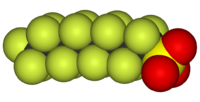
Enhanced electrocatalytic dechlorination of para-chloronitrobenzene based on Ni/Pd foam electrode
Sign Up to like & getrecommendations! Published in 2017 at "Chemical Engineering Journal"
DOI: 10.1016/j.cej.2017.01.024
Abstract: Abstract The electrochemical dechlorination of para -chloronitrobenzene ( p -CNB) was investigated in order to reduce the impact on environment. Based on the sponge-like structure of Ni foam and the catalytic activity of Pd, the… read more here.
Keywords: para chloronitrobenzene; foam electrode; electrocatalytic dechlorination; dechlorination ... See more keywords

Effects of different carbon substrates on performance, microbiome community structure and function for bioelectrochemical-stimulated dechlorination of tetrachloroethylene
Sign Up to like & getrecommendations! Published in 2018 at "Chemical Engineering Journal"
DOI: 10.1016/j.cej.2018.07.082
Abstract: Abstract Bioelectrochemical stimulation is regarded as a promising approach for enhanced dechlorination of chlorinated aliphatic hydrocarbons (CAHs). However, variation in microbiome structure and function corresponding to different carbon substrates remain poorly understood. In this study,… read more here.
Keywords: different carbon; dechlorination; carbon; structure function ... See more keywords

Ultrafine palladium nanoparticles supported on 3D self-supported Ni foam for cathodic dechlorination of florfenicol
Sign Up to like & getrecommendations! Published in 2019 at "Chemical Engineering Journal"
DOI: 10.1016/j.cej.2018.11.099
Abstract: Abstract Electrocatalytic hydrodechlorination is deemed as a promising environmental remediation technology for fast and effective detoxification of halogenated antibiotic pollutants. In this study, a novel nickel (Ni) foam electrode decorated by ultrafine palladium (Pd) nanoparticles… read more here.
Keywords: foam; dechloridation; dechlorination; palladium nanoparticles ... See more keywords

Insights into interactions between vanadium (V) bio-reduction and pentachlorophenol dechlorination in synthetic groundwater
Sign Up to like & getrecommendations! Published in 2019 at "Chemical Engineering Journal"
DOI: 10.1016/j.cej.2019.121965
Abstract: Abstract Aquifer co-contamination by vanadium (V) and pentachlorophenol (PCP) involves complicated biogeochemical processes that remain poorly understood, particularly from the perspective of microbial metabolism. Batch experiment results demonstrated that V(V) and PCP could be competitively… read more here.
Keywords: pentachlorophenol; dechlorination; interactions vanadium; insights interactions ... See more keywords

Highly efficient electrochemical dechlorination of florfenicol by an ultrathin molybdenum disulfide cathode
Sign Up to like & getrecommendations! Published in 2022 at "Chemical Engineering Journal"
DOI: 10.1016/j.cej.2021.131600
Abstract: Abstract The efficient elimination of biotoxicity of halogenated antibiotics by electrochemical dehalogenation pretreatment is required by a subsequent biochemical treatment process. Molybdenum disulfide (MoS2) has been applied as an efficient catalyst for the hydrogen evolution… read more here.
Keywords: ultrathin mos2; mos2; dechlorination; electrochemical dechlorination ... See more keywords

Recovering precipitates from dechlorination process of saline wastewater as poly aluminum chloride
Sign Up to like & getrecommendations! Published in 2022 at "Chemical Engineering Journal"
DOI: 10.1016/j.cej.2021.131612
Abstract: Abstract Chemical sludge massively generated from chloride removal of saline wastewater by the Friedel’s salt precipitation method is difficult to handle and dispose. In this study, a novel process was proposed to recover dechlorination precipitate… read more here.
Keywords: wastewater poly; dechlorination; saline; poly aluminum ... See more keywords

Element doping of biochars enhances catalysis of trichloroethylene dechlorination
Sign Up to like & getrecommendations! Published in 2022 at "Chemical Engineering Journal"
DOI: 10.1016/j.cej.2021.132496
Abstract: Abstract Biochar (BC) is used for reductive dehalogenation and detoxification of chlorinated ethylenes, and its catalytic reactivity strongly depends on the type and composition of the biomass. This study aimed to alter the catalytic activity… read more here.
Keywords: catalytic reactivity; trichloroethylene; doping biochars; reactivity ... See more keywords

A statistical shrinking core model to estimate the overall dechlorination rate of PCE by an assemblage of zero-valent iron nanoparticles
Sign Up to like & getrecommendations! Published in 2017 at "Chemical Engineering Science"
DOI: 10.1016/j.ces.2017.04.007
Abstract: Abstract A parametric shrinking-core model is used to quantify the dechlorination rate of chlorinated pollutants dissolved in water by zero-valent iron nanoparticles (nZVI). The mass-transfer processes are coupled with the instantaneous reaction occurring in the… read more here.
Keywords: shrinking core; model; dechlorination; rate ... See more keywords

Effects of biochar on dechlorination of hexachlorobenzene and the bacterial community in paddy soil.
Sign Up to like & getrecommendations! Published in 2017 at "Chemosphere"
DOI: 10.1016/j.chemosphere.2017.07.139
Abstract: Anaerobic reductive dechlorination is an important degradation pathway for chlorinated organic contaminants in paddy soil. This study investigated the effects of amending paddy soil with wheat straw biochar on both the dechlorination of hexachlorobenzene (HCB),… read more here.
Keywords: dechlorination hcb; paddy soil; biochar; dechlorination ... See more keywords

Screening of zero valent mono/bimetallic catalysts and recommendation of Raney Ni (without reducing agent) for dechlorination of 4-chlorophenol.
Sign Up to like & getrecommendations! Published in 2020 at "Chemosphere"
DOI: 10.1016/j.chemosphere.2020.126298
Abstract: Chlorophenol (CP) is considered as environmentally hazardous material due to its acute toxicity, persistent nature and strong bioaccumulation. The dechlorination of 4-CP was investigated by using various catalysts such as bimetallic (Fe0/Cu0, Al0/Fe0), Pd/C, Raney… read more here.
Keywords: agent dechlorination; reducing agent; raney; dechlorination ... See more keywords

Electrochemically mediated reduction of epichlorohydrin pollutant by Ni(I)(hexamethylcyclam) in aqueous media
Sign Up to like & getrecommendations! Published in 2017 at "Electrochimica Acta"
DOI: 10.1016/j.electacta.2017.02.147
Abstract: Abstract Epichlorohydrin (ECH) is a volatile organic compound and toxic to human health. Here we investigated clean mediated electrocatalytic dechlorination of ECH in aqueous solutions using electrogenerated [Nickel(I)(hexamethylcyclam)] + ([Ni(I)(hmc)] + ) at glassy carbon… read more here.
Keywords: hexamethylcyclam; epichlorohydrin; ech; dechlorination ... See more keywords